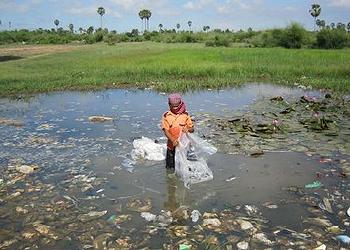
NEW YORK, New York, October 23, 2012 (ENS) – Industrial pollution is a critical public health threat on a par with malaria and tuberculosis, but while 125 million people around the world are at risk from toxic pollutants, these causes of illness and death are underestimated, new research shows.
Two nonprofit organizations – the New York-based Blacksmith Institute and Green Cross Switzerland – today issued a report detailing their findings from the past year of research on thousands of polluted sites in dozens of low-income and middle-income countries.

“The lack of investigation and quantification of the human health impacts of contaminated sites have left an often-marginalized population with few resources to address this growing problem. Sadly, health impacts from environmental pollution often affect the most vulnerable, especially children, within these already neglected populations,” the report states.
The objective of the work of the Blacksmith Institute and Green Cross Switzerland and one goal of this report is “to give a voice to this marginalized population that is in danger from toxic pollutants.”
The report identifies the 10 most toxic industries responsible for the greatest number of illnesses and deaths – number one on the list is lead-acid battery recycling.
The world’s second most toxic industry is lead smelting, with mining and ore processing ranked third, the report finds.
Investigators found that the fourth most polluting industry is tannery operations, even more toxic than industrial and municipal dump sites and industrial estates, which ranked fifth and sixth.
Artisinal gold mining is next on the list, while product manufacturing, chemical manufacturing and the dye industry round out the list of the 10 most polluting industries.
Funded by the European Union, the World Bank and Green Cross, Blacksmith investigated more than 2,600 sites in 49 countries in most regions of the world. Only North Africa and the Middle East are not represented due to what investigators called “security concerns.”

The toxic that causes the most illness is lead, which impairs the neurological development of children and causes cardiovascular disease in adults, according to the report, which is based on methods detailed by the World Health Organization.
Next most deadly is cancer-causing chromium, then comes mercury, which damages the kidneys and affects neurological development in children. Cadmium causes cancer and kidney disease, asbestos is responsible for mesothelioma, lung cancers and other lung problems, and a long list of volatile organic compounds cause cancer, neurological issues, and damage to kidneys, liver, skin other organs.
Blacksmith investigators identified over 500 sites polluted by lead, putting an estimated 16 million people at risk. They found that the top sources contributing to lead pollution, by population, are lead smelting, mining and ore processing, industrial estates and lead-acid battery recycling and manufacturing.
Stephan Robinson of Green Cross told reporters on a teleconference today, “Global production of lead was expected to increase nine percent in 2011 to 4.52 million tons, due to increases in China, India and Mexico, with China accounting for one-half of all lead mining production.”
Increasing quantities of lead are being recycled. But often recycling occurs at uncontrolled or poorly controlled facilities in the informal economic sector, even at home, making lead reprocessing itself a big problem in many countries, he said.
Richer countries can also be at risk if they travel on leaded fuel or use lead glazed pottery, the report shows.
“Mining has a lot of impact,” Robinson said. “It is extremely destructive to extract metal from ore. It is usually leached out in chemical process, which leaves a high volume of toxic sludges and heavy metals. Because the global population is growing, demand for ore is growing.”
“Often mining is a primitive process – people using only their bare hands and bare feet, with no protection – about 14 million people around the world are at risk from mining,” Robinson told reporters.
“Today there is modern technical equipment for pollution control, but it is expensive, so it exists only in rich, developed countries,” he said.
John Keith, a technical adviser with Blacksmith Institute, told reporters today that the biggest impacts of industrial pollution tend to be in low and middle income countries from “smaller industries producing for local markets, often in urban areas.”

In these countries there are fewer controls, less money for pollution control weight more toward local and smaller companies, he said.
“People need to make money. If they are poor, they will do what it takes to make money,” said Keith. “We are doing this research to develop solutions that protect their livelihoods, recover more gold, process hides more quickly.”
Keith says many of the sites investigated for this report are legacy sites with no current activity, but they are still polluting the surrounding air, land and water.
The World Health Organization has estimated that environmental exposures contribute to 19 percent of cancer incidence worldwide.
A WHO Global Health Risks report looked at five environmental exposures – unsafe water, sanitation and hygiene, urban outdoor air pollution, indoor smoke from solid fuels, lead exposure and climate change – and estimated they account for nearly 10 percent of deaths and disease burden globally and around one quarter of deaths and disease burden in children under the age of five.
The report concludes, “Making the connection between economics and human health is easy – the cost of illness and the loss of productivity due to disease and death is a huge and preventable economic burden.”
Copyright Environment News Service (ENS) 2012. All rights reserved.
© 2012, Environment News Service. All rights reserved. Content may be quoted only with proper attribution and a direct link to the original article. Full reproduction is prohibited.
